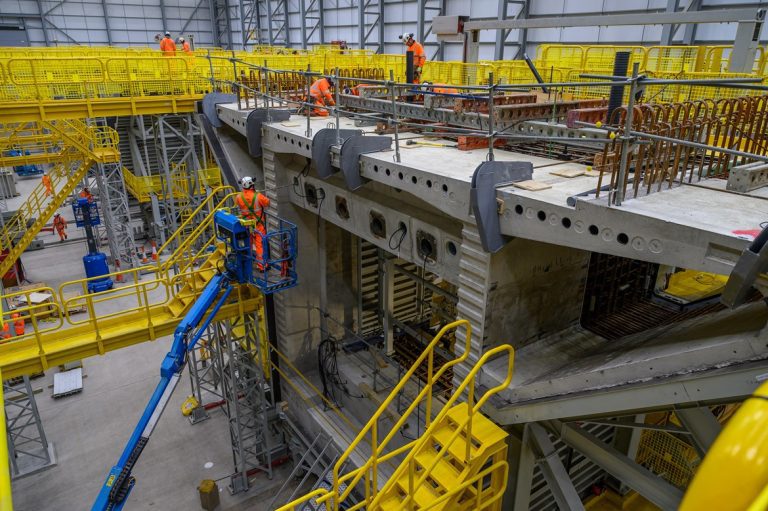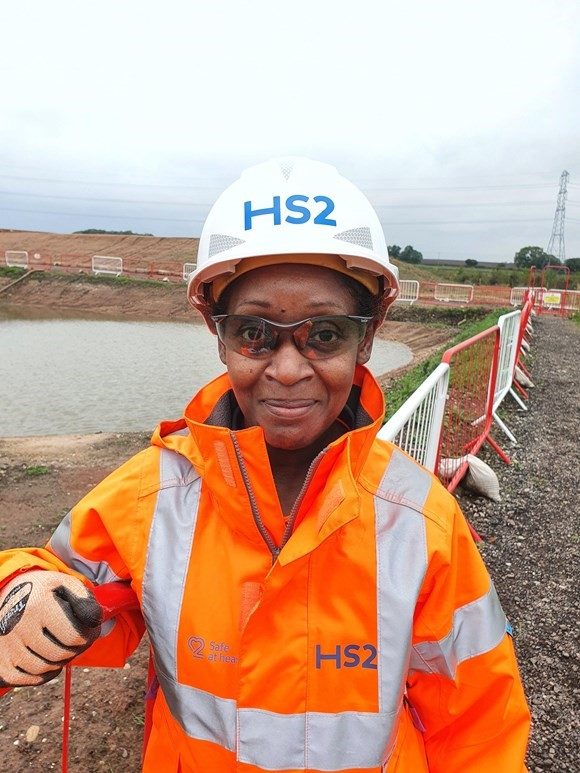HS2 was this week celebrating a literal milestone as ‘Florence’ – the first of ten Tunnel Boring Machines (TBMs) on Phase One completed her first mile of tunnel for the UK’s new high speed railway The latest photos of work on the Chiltern tunnel are available here: https://mediacentre.hs2.org.uk/resources/f/tbms-and-tunnels-massive-machines-and-their-current-progress/chiltern-tunnel-construction A new video flythrough of the first mile can be seen here: https://www.youtube.com/watch?v=1ZqmuTGVGZA The first enormous 2,000 tonne tunnelling machine passed the one mile mark this week during the construction of the first tunnels for HS2 – Britain’s new high speed rail link between London, Birmingham and the north. Launched in May, the 170m long Tunnel Boring Machine (TBM) covered the first mile cutting through a mix of chalk and flint beneath the Chiltern hills just outside London. Named ‘Florence’ by local school children, the TBM is one of two identical machines excavating the twin ten-mile-long tunnels. A second machine, named ‘Cecilia’ is a short way behind, with both TBMs expected to break out in around three years’ time. Designed specifically for the geology of the Chilterns, each machine is a self-contained underground factory, digging the tunnel, lining it with concrete wall segments and grouting them into place as it moves forward. Welcoming the progress, HS2 Ltd Project Client Rohan Perin said: “The 10 mile Chiltern tunnel will take HS2 underneath the hills and safeguard the woodlands and wildlife habits above ground as well as significantly reducing disruption to communities during construction and operation of the new railway. “Once complete, HS2 will offer low carbon journey options linking London with the major cities of the north and releasing capacity for more freight and local trains on our existing mainlines. It’s great to see how much progress has been made over the summer and I’d like to thank the crew of Florence and all the tunnelling team for their hard work.” The first two TBMs are operated by HS2’s main works contractor, Align – a joint venture formed of Bouygues Travaux Publics, Sir Robert McAlpine, and VolkerFitzpatrick. A crew of 17 people keep the machines running, working in shifts and supported by over 100 people on the surface, managing the logistics and maintaining the smooth progress of the tunnelling operation. Align Project Director Daniel Altier added: “I am delighted with the progress that Florence has made since its launch in May, with Cecilia not far behind. All the spoil from the TBMs is converted into slurry before being pumped back to our South Portal site, just inside the M25, where it is processed and used for landscaping on site. This is, and will continue to be, a huge logistical challenge, as Florence and Cecilia continue their journey through the Chilterns. “Florence reaching the 1 mile point is a great achievement, however we still have a long way to go.” Each of the separate northbound and southbound tunnels will require 56,000 precision engineered, fibre-reinforced concrete wall segments – which are all being made at the south portal of the tunnel, next to the M25. During her first mile, Florence and her crew have installed more than 5,500 separate segments, each weighing around 8.5 tonnes. Approximately 2.7 million cubic metres of material will be excavated during the construction of the tunnels and used for landscaping around the south portal site. Once construction is complete, this will help create around 90 hectares of wildlife-rich chalk grassland habitats. Chalk grassland used to be widespread across the hills of south east England and are considered habitat of international conservation significance with just 700ha left across the Chilterns. In total there will be ten TBMs on the HS2 project – working to create 64 miles of tunnel between London and the West Midlands including major tunnels on the approach to London and Birmingham. More than 20,000 jobs and over 650 apprenticeships are already being supported by HS2, which is set to transform transport links between Britain’s major cities, free up space on the rail network for more freight and local services and support the UK’s transition to net zero carbon emissions. The TBM is named after Florence Nightingale, the founder of modern nursing, who spent many years in Claydon, Buckinghamshire where she wrote books on nursing, with the name suggested by students at Meadow High School in Hillingdon. A new video flythrough of the first mile can be seen here: https://www.youtube.com/watch?v=1ZqmuTGVGZA An animation explaining the Chiltern tunnels can be found here: https://www.youtube.com/watch?v=dTsLL9BPHpc TBM names: Florence – named after Florence Nightingale, the founder of modern nursing, who spent many years in Claydon, Buckinghamshire where she wrote numerous books on nursing. Suggested by students at Meadow High School in Hillingdon. Cecilia – named after Cecilia Payne-Gaposchkin, the Astronomer and Astrophysicist born in Buckinghamshire who attended Cambridge University before becoming Chair of Astronomy at Harvard University in the United States. She was the first person to properly ‘read’ a temperature on stars. She also discovered that stars are made mainly from hydrogen and helium. Suggested by students at The Chalfonts Community College in Buckinghamshire. Around 4,500 people from across the UK then took part in the poll to select the final names, with Florence taking 40% of the vote and Cecilia a close second with 32%. Facts and figures – The Chiltern tunnel TBMs The TBMs are 170m in length – nearly 1.5 times the length of a football pitch Each one weighs roughly 2000 tonnes – the equivalent of 340 African bush elephants They were transported to the UK in 330 separate shipments containing a total of more than a thousand separate parts. They will run almost non-stop 24 hours a day for 3.5 years Once complete, trains will pass through the tunnel in around 3 minutes at speeds of up to 320km/h The tunnels will go as deep as 80m below the ground – ensuring communities and countryside above are not impacted by the railway The size of the TBM cutterhead which will bore the tunnels is 10.26m, roughly the height of two giraffes standing on top of one another Taking into account the thickness of the tunnel walls, the internal diameter of the tunnels in which the trains will pass through will be 9.1m, slightly larger than two London buses stacked on top of one another The tunnels will














